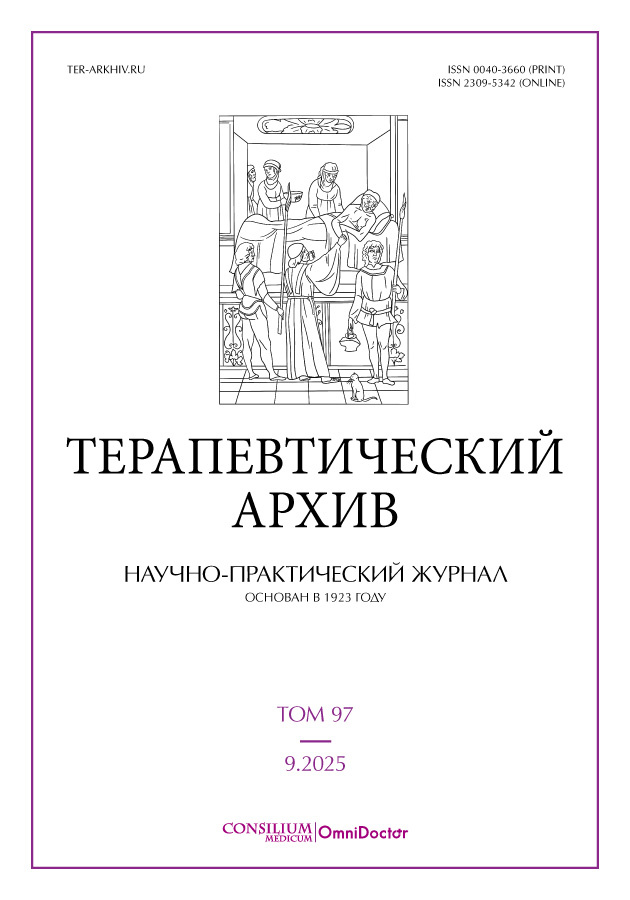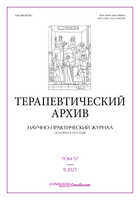Terapevticheskii arkhiv
Monthly peer-review medical journal
Editor-in-Chief
Irina Chazova
MD, PhD, Professor, Academician of the Russian academy of Sciences
ORCID: 0000-0002-1576-4877
About
Therapeutic archive journal (ISSN key title is "Terapevticheskiy arkhiv") was founded by the prominent Russian therapists M.P. Konchalovsky and G.F. Lang in 1923. Then its editors-in-chief were Professors V.N. Vinogradov and A.G. Gukasyan. Since 1972, E.I. Chazov, Academician of the Russian Academy of Sciences, has been heading the editorial board of the journal.
Over 90 years, there have been more than 1000 issues where the authors and editorial staff have done their best for readers to keep abreast of current advances in medical science and practice and for physicians to master the advanced principles of recognition and treatment of a wide spectrum of visceral diseases.
The papers published in the journal (editorials, original articles, lectures, reviews, etc.) cover both current scientific achievements and practical experience in diagnosing, treating, and preventing visceral diseases. The authors of publications are not only Russian, but also foreign scientists and physicians. All papers are peer-reviewed by highly qualified Russian specialists.
The journal is published monthly. Traditionally, each issue has predominantly certain thematic areas covering individual therapy specializations. Every year, one of the issues is devoted to related problems in practical medicine (allergology and immunology, neurology and psychiatry, obstetrics, oncology, etc.). This all draws the attention of the reading public to the journal.
Publications
Monthly issues publish in print and online in Open Access under the Creative Commons NC-ND 4.0 International Licensee.
Indexation
- Web of Science:
- Russian Science Citation Index (RSCI)
- Core Collection (Science Citation Index Expanded)
- PubMed/Medline
- Index Medicus
- Current Contents Connect
- BIOSIS Previews
- Scopus/EMBASE
- Ulrich’s Periodicals Directory
- Google Scholar
Current Issue
Vol 97, No 9 (2025): Issues of cardiology
- Year: 2025
- Published: 20.10.2025
- Articles: 8
- URL: https://ter-arkhiv.ru/0040-3660/issue/view/9263
Full Issue
Editorial article
Cardiology and cardiac surgery – a symbiosis of successful treatment of heart failure
Abstract
Currently, the proportion of patients with heart failure is progressively increasing. Despite the progress in drug therapy, additional manipulations are often necessary to correct cardiovascular pathology in these patients. Given the high comorbidity, the use of classical surgical techniques is impossible in some cases. Implantation of high-tech devices, catheter ablation of arrhythmogenic areas, transcatheter mitral valve plastic surgery are minimally invasive surgical methods. Proper interaction between a cardiologist and a cardiovascular surgeon allows for the maximum personalization of the approach to the treatment of each patient, achieving maximum results with significantly reduced risks.
 762-772
762-772


Original articles
Phenotypic clusters of obesity: gender, clinical, laboratory and genetic characteristics
Abstract
Aim. To identify phenotypic clusters of patients with various types of obesity and to study their gender, clinical, laboratory and genetic characteristics.
Materials and methods. 100 patients (47 men and 53 women, median age 58.5 [50; 69] years) were included in the cross-sectional study. All patients underwent chest and retroperitoneal space computed tomography with the calculation of pericardial, perivascular adipose tissue volumes and the thickness of perirenal fat. Alleles and genotypes of the peroxisome proliferator activated receptor gamma (PPARG) rs1801282 polymorphism, angiotensin II receptor type 1 (AGTR1) rs5186 polymorphism, and vascular endothelial growth factor A (VEGF-A) rs699947 polymorphism were identified in all patients. Cluster analysis was performed with python version 3.11. using the k-means algorithm. Silhouette value 0.2.
Results. Cluster 1 (n=36) consisted of middle-aged patients (men – 38.9%) with hypertension (HTN) – 100%, combined obesity [general obesity (GO) – 61%, abdominal obesity (AO) – 100%, ectopic obesity – 80.5%] and dyslipidaemia (77.8%). Cluster 2 included 14 patients: elderly (77.8%) men (71.4%) with HTN (100%), combined obesity (GO – 92.8%, AO – 85.7%, ectopic obesity – 100%), high incidence of dyslipidaemia (92.8%) and target organ damage. Cluster 3 consisted of 21 patients, mostly elderly (87.5%) women (76.2%) with HTN (90.1%), AO (80.9%), without GO (0%) and perirenal obesity (0%). Cluster 4 consisted of 29 patients, mostly young men without HTN (0%) with isolated AO (72.4%). The highest prevalence of risky alleles of the studied polymorphisms was found in cluster 2 (25, 32.1, 64.3%). The frequency of risky alleles was low 10.3, 20.7 and 43.1% in the most metabolically favourable cluster 4 compared to cluster 2.
Conclusion. We identified 4 clusters of obese patients in our study. Among them, the most unfavorable from a metabolic and genetic point of view was cluster 2, and the most favourable was cluster 4.
 773-780
773-780


Use of dupilumab in patients with asthma in routine clinical practice: interim analysis of the international prospective REVEAL study in the Russian population
Abstract
Aim. To assess the baseline characteristics of patients receiving dupilumab for asthma treatment in real-world setting.
Materials and methods. This interim analysis included data from 74 patients aged ≥12 years across 6 Russian centers participating in the international prospective REVEAL study. Demographics, clinical characteristics, levels of T2 inflammatory biomarkers, lung function (FEV1), symptom control (ACQ-6), annualized exacerbation rates, T2 comorbidities, and healthcare resource utilization were assessed. Statistical analyses were performed using standard descriptive statistics.
Results. The mean age of the patients was 47.8 years, 60.8% were women. Severe asthma (GINA stage 5) was present in 71.6%. At baseline, 74.3% had comorbid CRSwNP, 62.2% had AR, and 10.8% had AD. Dupilumab treatment resulted in significant reductions in median FeNO (-62.5% by month 3) and IgE (36.70 IU/mL by month 24). Lung function and asthma control improved (mean ACQ-6 reduction to 0.9 by month 24). Substantial decreases in exacerbation rates, hospitalizations, and emergency medical care were observed. Positive effects on T2 comorbidities were evidenced by improvements in SNOT-22, AR-VAS and POEM scores. Treatment-emergent adverse events occurred in 9.5% of patients, with only one patient discontinuing therapy.
Conclusion. Dupilumab demonstrated high effectiveness and safety in the treatment of severe asthma in real-world setting, including improvement in symptom control, reduction in inflammatory markers and healthcare resource utilization. The results are consistent with data from randomized trials and confirm the feasibility of using dupilumab in patients with the T2 phenotype of asthma. This analysis is preliminary in nature, final conclusions will require study completion.
 781-788
781-788


Reviews
Cardiovascular-kidney-metabolic syndrome: the interdisciplinary approach. A review
Abstract
The revealed interrelationships between obesity, type 2 diabetes mellitus, cardiovascular diseases and chronic kidney disease are an important problem of modern healthcare worldwide, which is gradually becoming an epidemic. The study of these diseases in such a combination becomes the subject of discussion among scientists and the topic of various consensus documents. Factors such as hyperglycemia, insulin resistance, increased activity of the renin-angiotensin-aldosterone system, formation of glycation end products, oxidative stress, calcium metabolism disorders, mitochondrial malfunctions, and persistent chronic inflammation are fundamental to understanding of this syndrome (or disorder) and developing approaches to prevention and treatment. This review article describes both the basic principles of diagnosis and treatment of cardio renal metabolic syndrome and approaches to primary and secondary prevention.
 789-792
789-792


Vaccination pneumococcal infection and cardiovascular diseases: a review
Abstract
Cardiopulmonary comorbidity is a serious health threat at any age. Community-acquired pneumonia caused by Streptococcus pneumoniae has a proven negative effect in terms of the incidence of new and decompensation of known cardiovascular pathologies, such as myocardial infarction, cerebrovascular accident, heart failure. An additional incentive for the widespread use of pneumococcal vaccination is the good availability of the vaccine and the simple immunization schedule. However, current recommendations have significant differences of opinion regarding target groups for vaccination both among themselves and with the existing evidence base. Low prevalence of pneumococcal vaccination does not allow for the full use of even the well-known advantages of this method in reducing cardiovascular risk. The proposed review discusses possible mechanisms of the impact of pneumococcal infection on the human body, cardioprotective effects of vaccination, modern studies on the possibilities of vaccination among people with cardiovascular diseases; the effect of vaccination on the frequency of cardiovascular events and mortality is considered. The place of pneumococcal infection prevention in current clinical guidelines and its effect on patients' prognosis are indicated. The authors argue for the need for further research in order to obtain sufficient data on the protective effect of vaccination for specific cardiovascular diseases and target patient groups.
 793-799
793-799


Case reports
Left atrial myxoma in combination with hamartoma polyp of the esophagus and lentiginosis: diseases that have a common origin and different localization. Case report
Abstract
Myxoma refers to benign tumors and accounts for up to 50% of all primary neoplasms of the heart. Usually cases of myxoma as an independent disease are given. In the presented clinical case, left atrial myxoma was combined with lentiginosis: a lot of black papular rashes on the skin of the face, head, entire surface of the trunk and extremities, as well as black patches on the surface of the lips and a hamartoma polyp of the esophagus. These changes may be a manifestation of multiple hamartoma syndrome, which is a rarely diagnosed pathology. Another feature of the case is the onset of myxoma by the clinic of acute posterior myocardial infarction with ST segment elevation and pathological Q wave in a 29-year-old patient. According to coronary angiography, stenoses of the coronary arteries were not detected. A pronounced vasospasm of the left coronary artery was found. There was an increase in the level of lactate dehydrogenase 808.11 units/l and troponin I at admission up to 433.8 ng/ml, with an increase to 19 010 ng/ml. The given clinical example shows the importance of a comprehensive examination of patients with myxomas to exclude other hereditarily mediated syndromes, especially in the presence of skin pigmentation.
 800-805
800-805


Heart transplantation for transthyretin amyloidosis. Clinical case
Abstract
Amyloid cardiomyopathy is an infiltrative disease with extremely adverse prognosis. New treatments are now emerging, however they are not aimed at eliminating the existing deposits of amyloid, but at preventing new ones. Given the difficulties of diagnosing the disease at an early stage, patients often end up in the hospital with advanced heart failure. In such cases, the efficacy of a pathogenic therapy is extremely low, which makes the treatment of an advanced stage of the disease very important. The article discusses the possibility of heart transplantation for patients with amyloid cardiomyopathy. A clinical case of a patient with hereditary transthyretin amyloidosis who was performed biatric orthotopic heart transplantation is presented.
 806-813
806-813


History of medicine
Treatment of ventricular arrhythmias in patients with myocardial infarction: timeline
Abstract
Ventricular arrhythmias are common and life-threatening complications of myocardial infarction. The article describes the evolution of the research and implementation of methods for treating ventricular arrhythmias in myocardial infarction into clinical practice, and discusses possible trends in the future development of this area.
 814-818
814-818














